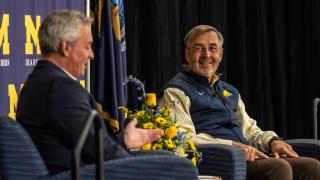
Without question, UM-Dearborn students have been complete champs throughout this entire pandemic response — including being super patient about ever-evolving plans for the fall. The good news is that much of the big picture has come into focus in recent weeks, including a plan for a “remote first” semester. University leaders shared more details about that and answered questions from students at a recent virtual town hall. We’ve summarized some of the highlights for you below, in case you missed it.
What campus will look like in the fall
You’ve likely already heard about the biggest change for fall: Most courses will be taught remotely, with only select classes, like labs and senior design, meeting in-person. This is of course being done to reduce density inside buildings, but there will be additional safety measures for those whose coursework or research takes them to campus. Masks will be required, as is a daily health screening, which students can complete online prior to their arrival. Buildings will have a single entrance, and you’ll be greeted by someone to verify that you’re symptom free. Once inside, classrooms and labs will also have strict social distancing and density requirements. Certain buildings and facilities, like the Wellness Center, will be closed; others, like Mardigian Library, will be available in a modified capacity. Students can expect lots of new signage on campus to guide them through this new routine. One additional bit of good news: Parking is free for the fall semester, and with a reduced on-campus student population, no one should have to fight for a great parking spot.
Student life will be virtual
As with academic life, student life will remain primarily virtual for the fall, though all services will still be available. This includes critical support services like the Student Food Pantry and mental health services from Counseling and Psychological Services. Even in a remote environment, there’s still a lot student organizations can do virtually, and Dean of Students Amy Finley encourages anyone involved in a student organization to reach out for ideas and tech help for organizing virtual events.
Why tuition was increased
Earlier this month, the U-M Board of Regents approved a 1.9 percent increase in tuition and fees for UM-Dearborn, which translates to a $124 increase for full-time, in-state, undergraduate students for the fall semester. At the town hall, Chancellor Grasso explained that the main reason for the increase was to protect financial aid offerings: “Our state appropriation is reserved primarily for financial aid — 89 percent of the money that comes from the state goes directly back to our students,” Grasso said. “We are still facing a potential cut in our state appropriation, maybe as much as $4 million. So for us to maintain the level of financial aid that we hope to provide to our students, we felt it necessary to raise tuition just slightly.”
Important updates about financial aid and class schedules
The switch to mostly remote classes necessitated changes to nearly 1,600 course sections, but Vice Provost for Enrollment Management Melissa Stone said most of that nitty gritty scheduling work is now done. As of this week, students can login to see if their classes are being taught remotely or in-person, and tuition and fees assessments will be mailed as well. Stone also said that this semester, the university is being more flexible with the terms of scholarship renewals, since the Pass/Fail grade option for the Winter 2020 semester may not have allowed students to meet their GPA requirements. (Eligibility will be reviewed on a case-by-case basis.) There’s also been an extension of the federal financial aid application deadline, so if students haven’t filed a FAFSA, it’s not too late. The new deadline is August 1.
Emergency aid for students
To date, UM-Dearborn has allocated about $1.9 million in emergency funding to nearly 1,300 students dealing with hardships related to the pandemic. This money comes from the federal CARES Act package, and Stone says there’s roughly the same amount of funding still available to students. Not everyone or every situation qualifies for CARES assistance; international students, for example, are not eligible. But in those cases, the university may still be able to help via a separate Immediate Relief Fund (IRF). You can find more details about CARES and IRF assistance.
A big relief for international students
It’s been a stressful couple of weeks for international students. Earlier this month, the Trump administration issued a Department of Homeland Security order that would have required international students to take at least some in-person courses to stay in the country. Under pressure from state governments and universities, the administration soon rescinded that order, allowing international students the same opportunities to study remotely this semester. The Office of International Affairs has held many town halls for international students, and these will continue through the summer to help answer their questions.
Two big unknowns
Needless to say, the evolving nature of the pandemic makes it difficult to plan too far into the future. Because of that, students will still have to tap into their well of patience on two big fronts: plans for Winter Commencement and the Winter 2021 semester. University leaders hope to announce details about the former in the coming weeks, and the latter, after the start of the fall term.
###
If you want to view the entire town hall, you can watch it here.





